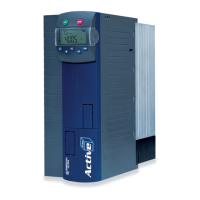The minimum number of revolutions needed until the required position is reached
depends on the Actual frequency 241 and Deceleration (clockwise) 421 (or Decel-
eration anticlockwise 423) as well as the No. of pole pairs 373 of the motor.
No. of pole pairs 373 of motor
Example: f = 20 Hz, a = 5 Hz/s, p = 2 ⇒ rpm
= 20
With an actual frequency of 20 Hz and a delay of 5 Hz/s, at least 20 rotations are
needed
until standstill at the required position. This is the minimum value for the
Positioning distance 460; a shorter positioning distance is not possible. If the num-
ber o
f rotations until the required position is reached is to be lower, the frequency
must be reduced, the deceleration increased, or the reference point must be shifted.
The digital signal for registration of the reference point and the logical assignment
are to be chosen from a selection of Signal source 459
. The link of the digital inputs
S2IND, S3IND and S6IND to further functions is to be checked accord
Configuration 30
(e.g., in configurations 110 and 210, digital input S2IND is linked
to the function "Start of clockwise operation").
The signals for positioning and a stopping behavior should not be assigned to the
same digital input.
2 - S2IND, neg. edge
The positioning starts with the change of the
logic signal from 1 (HIGH) to 0 (LOW) at the
reference point.
3 - S3IND, neg. edge
1x - SxIND, pos. edge
The positioning starts with the change of the
logic signal from 0 (LOW) to 1 (HIGH)
2x - SxIND, pos./neg. edge
The positioning begins with the change of the
logic signal
The registration of the reference position via a digital signal can be influenced by a
variable dead time while the control command is read and processed. The signal
running time is compensated by a positive figure for the Signal correction 461.
The
setting of a negative signal correction decelerates the processing of the digital signal.
461
Signal correction -327.68 ms +327.67 ms 0.00 ms
The influences on the positioning which depend on the operating point can be cor-
rected empirically via the Load correction 462
parameter. If the required position is
not reached, the deceleration duration is increased by a positive load correction val-
ue. The distance between the refe
rence point and the required position is extended.
Negative values accelerate the braking process and reduce the positioning distance.
The limit of the negative signal correction results from the application and the Posi-
460.
462
Load correction -32768 +32767 0
06/13 Operating Instructions ACU 145

